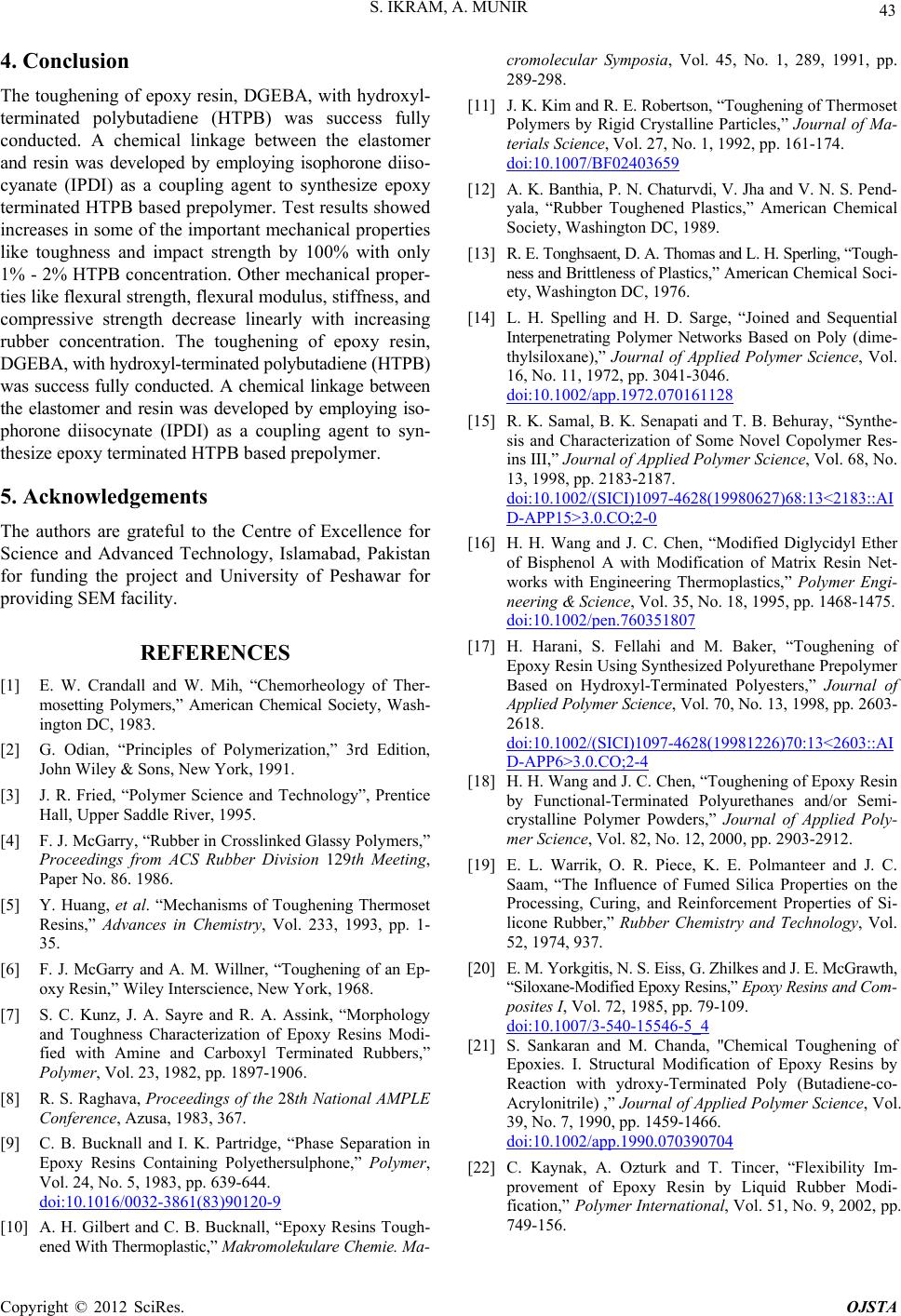
S. IKRAM, A. MUNIR
Copyright © 2012 SciRes. OJSTA
43
4. Conclusion
The toughening of epoxy resin, DGEBA, with hydroxyl-
terminated polybutadiene (HTPB) was success fully
conducted. A chemical linkage between the elastomer
and resin was developed by employing isophorone diiso-
cyanate (IPDI) as a coupling agent to synthesize epoxy
terminated HTPB based prepolymer. Test results showed
increases in some of the important mechanical properties
like toughness and impact strength by 100% with only
1% - 2% HTPB concentration. Other mechanical proper-
ties like flexural strength, flexural modulus, stiffness, and
compressive strength decrease linearly with increasing
rubber concentration. The toughening of epoxy resin,
DGEBA, with hydroxyl-terminated polybutadiene (HTPB)
was success fully conducted. A chemical linkage between
the elastomer and resin was developed by employing iso-
phorone diisocynate (IPDI) as a coupling agent to syn-
thesize epoxy terminated HTPB based prepolymer.
5. Acknowledgements
The authors are grateful to the Centre of Excellence for
Science and Advanced Technology, Islamabad, Pakistan
for funding the project and University of Peshawar for
providing SEM facility.
REFERENCES
[1] E. W. Crandall and W. Mih, “Chemorheology of Ther-
mosetting Polymers,” American Chemical Society, Wash-
ington DC, 1983.
[2] G. Odian, “Principles of Polymerization,” 3rd Edition,
John Wiley & Sons, New York, 1991.
[3] J. R. Fried, “Polymer Science and Technology”, Prentice
Hall, Upper Saddle River, 1995.
[4] F. J. McGarry, “Rubber in Crosslinked Glassy Polymers,”
Proceedings from ACS Rubber Division 129th Meeting,
Paper No. 86. 1986.
[5] Y. Huang, et al. “Mechanisms of Toughening Thermoset
Resins,” Advances in Chemistry, Vol. 233, 1993, pp. 1-
35.
[6] F. J. McGarry and A. M. Willner, “Toughening of an Ep-
oxy Resin,” Wiley Interscience, New York, 1968.
[7] S. C. Kunz, J. A. Sayre and R. A. Assink, “Morphology
and Toughness Characterization of Epoxy Resins Modi-
fied with Amine and Carboxyl Terminated Rubbers,”
Polymer, Vol. 23, 1982, pp. 1897-1906.
[8] R. S. Raghava, Proceedings of the 28th National AMPLE
Conference, Azusa, 1983, 367.
[9] C. B. Bucknall and I. K. Partridge, “Phase Separation in
Epoxy Resins Containing Polyethersulphone,” Polymer,
Vol. 24, No. 5, 1983, pp. 639-644.
doi:10.1016/0032-3861(83)90120-9
[10] A. H. Gilbert and C. B. Bucknall, “Epoxy Resins Tough-
ened With Thermoplastic,” Makromolekulare Chemie. Ma-
cromolecular Symposia, Vol. 45, No. 1, 289, 1991, pp.
289-298.
[11] J. K. Kim and R. E. Robertson, “Toughening of Thermoset
Polymers by Rigid Crystalline Particles,” Journal of Ma-
terials Science, Vol. 27, No. 1, 1992, pp. 161-174.
doi:10.1007/BF02403659
[12] A. K. Banthia, P. N. Chaturvdi, V. Jha and V. N. S. Pend-
yala, “Rubber Toughened Plastics,” American Chemical
Society, Washington DC, 1989.
[13] R. E. Tonghsaent, D. A. Thomas and L. H. Sperling, “Tough-
ness and Brittleness of Plastics,” American Chemical Soci-
ety, Washington DC, 1976.
[14] L. H. Spelling and H. D. Sarge, “Joined and Sequential
Interpenetrating Polymer Networks Based on Poly (dime-
thylsiloxane),” Journal of Applied Polymer Science, Vol.
16, No. 11, 1972, pp. 3041-3046.
doi:10.1002/app.1972.070161128
[15] R. K. Samal, B. K. Senapati and T. B. Behuray, “Synthe-
sis and Characterization of Some Novel Copolymer Res-
ins III,” Journal of Applied Polymer Science, Vol. 68, No.
13, 1998, pp. 2183-2187.
doi:10.1002/(SICI)1097-4628(19980627)68:13<2183::AI
D-APP15>3.0.CO;2-0
[16] H. H. Wang and J. C. Chen, “Modified Diglycidyl Ether
of Bisphenol A with Modification of Matrix Resin Net-
works with Engineering Thermoplastics,” Polymer Engi-
neering & Science, Vol. 35, No. 18, 1995, pp. 1468-1475.
doi:10.1002/pen.760351807
[17] H. Harani, S. Fellahi and M. Baker, “Toughening of
Epoxy Resin Using Synthesized Polyurethane Prepolymer
Based on Hydroxyl-Terminated Polyesters,” Journal of
Applied Polymer Science, Vol. 70, No. 13, 1998, pp. 2603-
2618.
doi:10.1002/(SICI)1097-4628(19981226)70:13<2603::AI
D-APP6>3.0.CO;2-4
[18] H. H. Wang and J. C. Chen, “Toughening of Epoxy Resin
by Functional-Terminated Polyurethanes and/or Semi-
crystalline Polymer Powders,” Journal of Applied Poly-
mer Science, Vol. 82, No. 12, 2000, pp. 2903-2912.
[19] E. L. Warrik, O. R. Piece, K. E. Polmanteer and J. C.
Saam, “The Influence of Fumed Silica Properties on the
Processing, Curing, and Reinforcement Properties of Si-
licone Rubber,” Rubber Chemistry and Technology, Vol.
52, 1974, 937.
[20] E. M. Yorkgitis, N. S. Eiss, G. Zhilkes and J. E. McGrawth,
“Siloxane-Modified Epoxy Resins,” Epoxy Resins and Com-
posites I, Vol. 72, 1985, pp. 79-109.
doi:10.1007/3-540-15546-5_4
[21] S. Sankaran and M. Chanda, "Chemical Toughening of
Epoxies. I. Structural Modification of Epoxy Resins by
Reaction with ydroxy-Terminated Poly (Butadiene-co-
Acrylonitrile) ,” Journal of Applied Polymer Science, Vol.
39, No. 7, 1990, pp. 1459-1466.
doi:10.1002/app.1990.070390704
[22] C. Kaynak, A. Ozturk and T. Tincer, “Flexibility Im-
provement of Epoxy Resin by Liquid Rubber Modi-
fication,” Polymer International, Vol. 51, No. 9, 2002, pp.
749-156.